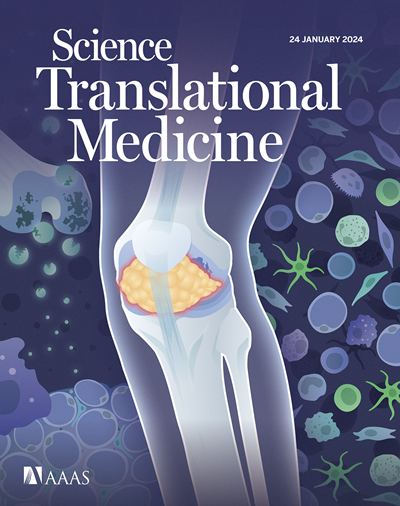Long-acting refillable nanofluidic implant confers protection against SHIV infection in nonhuman primates
IF 14.6
1区 医学
Q1 CELL BIOLOGY
引用次数: 2
Abstract
The impact of pre-exposure prophylaxis (PrEP) on slowing the global HIV epidemic hinges on effective drugs and delivery platforms. Oral drug regimens are the pillar of HIV PrEP, but variable adherence has spurred development of long-acting delivery systems with the aim of increasing PrEP access, uptake, and persistence. We have developed a long-acting subcutaneous nanofluidic implant that can be refilled transcutaneously for sustained release of the HIV drug islatravir, a nucleoside reverse transcriptase translocation inhibitor that is used for HIV PrEP. In rhesus macaques, the islatravir-eluting implants achieved constant concentrations of islatravir in plasma (median 3.14 nM) and islatravir triphosphate in peripheral blood mononuclear cells (median 0.16 picomole per 106 cells) for more than 20 months. These drug concentrations were above the established PrEP protection threshold. In two unblinded, placebo-controlled studies, islatravir-eluting implants conferred 100% protection against infection with SHIVSF162P3 after repeated low-dose rectal or vaginal challenge in male or female rhesus macaques, respectively, compared to placebo control groups. The islatravir-eluting implants were well tolerated with mild local tissue inflammation and no signs of systemic toxicity over the 20-month study period. This refillable islatravir-eluting implant has potential as a long-acting drug delivery system for HIV PrEP.
长效可再充注纳米流体植入物可保护非人灵长类动物免受 SHIV 感染
暴露前预防疗法(PrEP)对减缓全球艾滋病疫情的影响取决于有效的药物和给药平台。口服药物疗法是艾滋病毒预防性治疗的支柱,但由于依从性参差不齐,促使人们开发长效给药系统,以提高预防性治疗的可及性、吸收率和持久性。我们开发了一种长效皮下纳米流体植入物,它可以经皮再充注,持续释放艾滋病药物伊斯拉曲韦(islatravir),这是一种核苷类逆转录酶转位抑制剂,用于艾滋病预防性治疗。在猕猴体内,伊斯拉曲韦洗脱植入物可使血浆中的伊斯拉曲韦浓度(中位数为 3.14 nM)和外周血单核细胞中的三磷酸伊斯拉曲韦浓度(中位数为每 106 个细胞 0.16 皮摩尔)保持稳定,持续时间超过 20 个月。这些药物浓度均高于既定的 PrEP 保护阈值。在两项非盲法安慰剂对照研究中,与安慰剂对照组相比,伊斯拉曲韦洗脱植入剂在雄性或雌性恒河猴反复低剂量直肠或阴道挑战后,可100%预防SHIVSF162P3感染。在长达 20 个月的研究期间,伊斯拉特韦洗脱植入物的耐受性良好,局部组织炎症轻微,无全身毒性症状。这种可再充填的伊斯拉曲韦洗脱植入物有望成为艾滋病预防性治疗的长效给药系统。
本文章由计算机程序翻译,如有差异,请以英文原文为准。
求助全文
约1分钟内获得全文
求助全文
来源期刊

Science Translational Medicine
CELL BIOLOGY-MEDICINE, RESEARCH & EXPERIMENTAL
CiteScore
26.70
自引率
1.20%
发文量
309
审稿时长
1.7 months
期刊介绍:
Science Translational Medicine is an online journal that focuses on publishing research at the intersection of science, engineering, and medicine. The goal of the journal is to promote human health by providing a platform for researchers from various disciplines to communicate their latest advancements in biomedical, translational, and clinical research.
The journal aims to address the slow translation of scientific knowledge into effective treatments and health measures. It publishes articles that fill the knowledge gaps between preclinical research and medical applications, with a focus on accelerating the translation of knowledge into new ways of preventing, diagnosing, and treating human diseases.
The scope of Science Translational Medicine includes various areas such as cardiovascular disease, immunology/vaccines, metabolism/diabetes/obesity, neuroscience/neurology/psychiatry, cancer, infectious diseases, policy, behavior, bioengineering, chemical genomics/drug discovery, imaging, applied physical sciences, medical nanotechnology, drug delivery, biomarkers, gene therapy/regenerative medicine, toxicology and pharmacokinetics, data mining, cell culture, animal and human studies, medical informatics, and other interdisciplinary approaches to medicine.
The target audience of the journal includes researchers and management in academia, government, and the biotechnology and pharmaceutical industries. It is also relevant to physician scientists, regulators, policy makers, investors, business developers, and funding agencies.
 求助内容:
求助内容: 应助结果提醒方式:
应助结果提醒方式:


